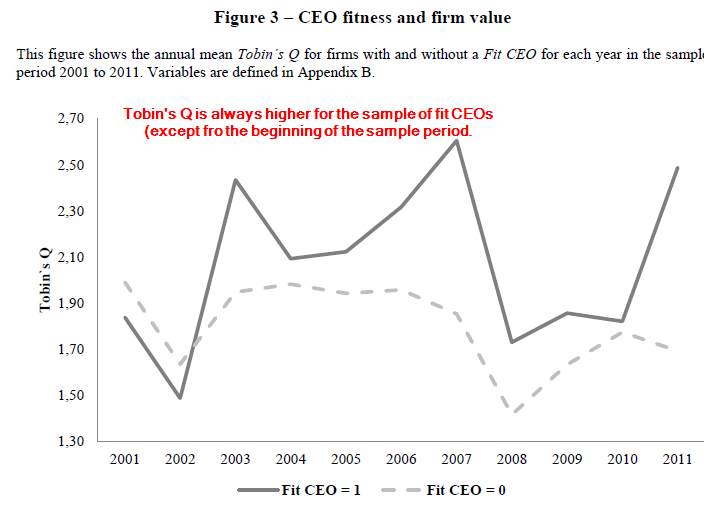CEO Fitness and Firm Value
- Limbach and Sonnenburg
- A version of the paper can be found here.
- Want a summary of academic papers with alpha? Check out our Academic Research Recap Category.
Abstract:
We provide evidence for a positive impact of CEO fitness on firm value (Tobin’s Q). For each of the years 2001 to 2011, we define S&P 1500 CEOs as fit if they finish a marathon. Fit CEOs are associated with higher firm profitability and M&A announcement returns. Effects on firm value are strongest for CEOs with above-median age, above-median tenure and high workload, consistent with the positive impact of fitness on cognitive functions, performance and stress coping found in the literature. Results are robust to tests for endogeneity, including CEO-firm fixed effects, time-varying firm and industry effects, reverse causality, permutation tests, and sudden deaths. They provide an explanation for the growing importance of fitness in the managerial labor market.
Alpha Highlight:
There is a growing body of literature about how CEOs’ physiology can affect their compensation and firm performance. Examples include facial attractiveness, a competent look, and so on (Graham, Harvey, and Puri, 2014, Halford and Hsu, 2013). In this paper, the authors illustrate another important physical aspect that may affect firm value: A CEOs’ level of fitness. The authors define CEOs as being “fit” if they finish a marathon, which is a good proxy for fitness. Firm value is measured by Tobin’s Q. The authors identify the following empirical facts:
- Around 6% of all CEOs are “fit.” The fraction of CEOs with at least one finished marathons has almost doubled between 2001 and 2011.
- From the panel regression of 9,500 firm-year observations from 2001 to 2011, the paper find that CEOs who finish a marathon in a given year are associated with a significantly higher firm value (Tobin’s Q) and higher M&A abnormal returns.

In line with the emerging importance of CEO fitness, there is a growing trend among executives to participate in endurance sports, especially marathons.
Key Findings:
- Firm value is almost 5% higher on average for firms managed by a fit CEO, after controlling for other factors (firm and governance characteristics, past performance and firm fixed effects).
- Fit CEOs also perform better on large corporate investments, like mergers and acquisitions (M&As).
- Fitness is even more important for older managers.

The results are hypothetical results and are NOT an indicator of future results and do NOT represent returns that any investor actually attained. Indexes are unmanaged, do not reflect management or trading fees, and one cannot invest directly in an index. Additional information regarding the construction of these results is available upon request.
The regression estimates formally tests the relationship between firm value and the “Fit CEO” variable. The empirical results support this paper’s conclusions.

The results are hypothetical results and are NOT an indicator of future results and do NOT represent returns that any investor actually attained. Indexes are unmanaged, do not reflect management or trading fees, and one cannot invest directly in an index. Additional information regarding the construction of these results is available upon request.
We are doing our piece to get in shape. Here is the Alpha Architect team finishing up the Mighty Hamptons Olympic Triathalon last weekend.

About the Author: Wesley Gray, PhD
—
Important Disclosures
For informational and educational purposes only and should not be construed as specific investment, accounting, legal, or tax advice. Certain information is deemed to be reliable, but its accuracy and completeness cannot be guaranteed. Third party information may become outdated or otherwise superseded without notice. Neither the Securities and Exchange Commission (SEC) nor any other federal or state agency has approved, determined the accuracy, or confirmed the adequacy of this article.
The views and opinions expressed herein are those of the author and do not necessarily reflect the views of Alpha Architect, its affiliates or its employees. Our full disclosures are available here. Definitions of common statistics used in our analysis are available here (towards the bottom).
Join thousands of other readers and subscribe to our blog.


